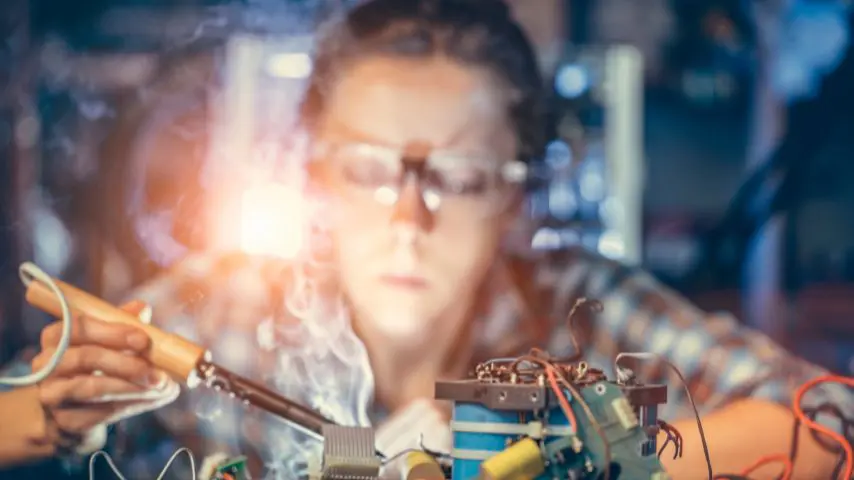The Promise and Challenge of Problem-Based Learning
The Promise and Challenge of Problem-Based Learning


STEM educators call for more standardized problem-based learning projects and curriculum so they can start to think and work like an engineer. Photo: Siemens
Tess Strauch quickly grows bored when she reverts to traditional teaching methods like lecturing her STEM students while they sit quietly and take notes. She would much rather use the hands-on labs and collaborative learning strategies at the core of problem-based learning (PBL). Strauch knows her students feel the same.
“You can see their brains clicking, thinking, and seeing things through. It gives them the sort of engagement they find in doing something new during the school day,” said Strauch, who teaches engineering, physics, and marine biology at Bethpage High School in New York. “It also makes them critically think, problem-solve, and communicate and cooperate with one another. All of those skills are preferred by students, whether they admit to it or not.”
As a teacher, Strauch enjoys teaching PBL methods as much as her students enjoy learning from them. Despite the upsides of PBL and the amount of time and resources people are spending to improve it, the approach poses several ongoing challenges to the teachers, students, and school departments that implement it, Strauch and others said.
PBL teaches students a core curriculum through hands-on activities to solve a design problem related to a real-world challenge or issue. It’s been around in some form since the ancient Greeks. During the last decade, PBL had gained momentum when aspects of it were incorporated into the Next Generation Science Standards (NGSS), which takes a research-based, hands-on approach to improve learning. The standards also encompass engineering. About 44 states have either adopted the full standards or shown interest in them.
The problem is that no matter how committed a school district is to the NGSS, each doesn’t necessarily incorporate the same amount of PBL into its curriculum. While there has been much effort and energy spent creating quality PBL lessons, the curriculums haven’t been standardized, curated, or archived effectively. For example, a 10th-grade engineering teacher today cannot easily access PBL lessons to cover a full school year’s curriculum.
“You sort of use what you stumble upon,” said Strauch, adding that her former school district in South Carolina fully embraced PBL methods six years ago, during her second year of teaching, but her current school has yet to. “We need a widely accessible curriculum for PBL to encourage more people to do it.”
Educators face a number of other challenges when trying to adopt PBL. Those include overcoming the reluctance of both students and teachers to embrace a different approach to learning. To truly use PBL appropriately requires devoting the time to develop PBL-related labs and curriculum, acquiring the materials needed for projects (especially in less affluent school districts), and incorporating in the projects the information students need to pass standardized tests. However, the majority of those challenges can be addressed through a comprehensive and properly developed curriculum, experts said.
“It’s what the teachers need,” said Dick Blais. He has been developing PBL curriculum since the 1980s and most recently, along with his business partner, Tom White, designed the Siemens Engineering Design STEM curriculum. “The teachers can’t develop it on their own. They don’t have the time to do that.”
Siemens’ free courses, designed for K-12 students, are based around the use of the company’s Solid Edge design software, Solid Edge CAM Pro, or TIA Portal Software. The curriculum uses PBL to shift the emphasis of learning from the traditional practice of an educator teaching students to master procedures to encourage a student’s original thinking and collaboration with team members.
“The role of the teacher is not to be the lecturer. We don’t want ‘the sage on the stage,’” Blais said. “The right role for the teacher is to be the advisor, the coach; guiding students, encouraging them, and giving them the confidence to take bold steps and not to be afraid of failure.”
The Siemens curriculum uses many of the key components that make up the core foundation of today’s widely taught PBL methods. They include:
“Students need to be able to communicate it to a group of outside reviewers,” Blais said. “That’s what colleges want students to be able to do. That’s what industry wants their workers to do.”
Strauch, who took the Siemens course and incorporated its curriculum into her PBL classes, said those final presentations are among the most critical and challenging aspects of PBL. They also help educators develop the patience they need to implement PBL successfully until standardized curriculums are fully developed, Strauch said.
“Just having students present at the level you want them to be at is a challenge,” she said. “There are some parts of PBL where you just have to accept that students may not learn it in the way you might have preferred them to. But you have to be okay with that.”
To overcome some of the other challenges associated with PBL, Strauch mixes creativity with that much-needed patience. She’ll ease classes into PBL by adding traditional teaching methods to the process and schedule the extra time needed to create a curriculum. That’s true even if she finds a comprehensive PBL project, like the Mission to Mars project she came across on the George Lucas Educational Foundation. That project is also aligned to the AP physics test, which Strauch said is a big help in preparing students for exams. Throughout the year, she’ll also have students collect whatever materials (household items, shoeboxes, etc.) are needed for upcoming projects.
And, yes, Strauch still has her students take notes. But instead of beginning the curriculum with a long lecture to hammer home essential information, she’ll wait for that magic moment during a hands-on project when a student starts talking about something – terminal velocity or gravity or electricity – that the rest of the class needs to know about. She’ll then let the student do the teaching.
“I feel like when you’re using the old, traditional way of teaching science, the students aren’t really experiencing science,” Strauch said. “PBL helps them think the way an engineer or a scientist thinks about things.”
Jeff O’Heir is a science and technology writer based in Huntington, NY.
Learn more by visiting Siemens' Solid Edge Learning Resources for Educators
“You can see their brains clicking, thinking, and seeing things through. It gives them the sort of engagement they find in doing something new during the school day,” said Strauch, who teaches engineering, physics, and marine biology at Bethpage High School in New York. “It also makes them critically think, problem-solve, and communicate and cooperate with one another. All of those skills are preferred by students, whether they admit to it or not.”
As a teacher, Strauch enjoys teaching PBL methods as much as her students enjoy learning from them. Despite the upsides of PBL and the amount of time and resources people are spending to improve it, the approach poses several ongoing challenges to the teachers, students, and school departments that implement it, Strauch and others said.
PBL teaches students a core curriculum through hands-on activities to solve a design problem related to a real-world challenge or issue. It’s been around in some form since the ancient Greeks. During the last decade, PBL had gained momentum when aspects of it were incorporated into the Next Generation Science Standards (NGSS), which takes a research-based, hands-on approach to improve learning. The standards also encompass engineering. About 44 states have either adopted the full standards or shown interest in them.
The problem is that no matter how committed a school district is to the NGSS, each doesn’t necessarily incorporate the same amount of PBL into its curriculum. While there has been much effort and energy spent creating quality PBL lessons, the curriculums haven’t been standardized, curated, or archived effectively. For example, a 10th-grade engineering teacher today cannot easily access PBL lessons to cover a full school year’s curriculum.
“You sort of use what you stumble upon,” said Strauch, adding that her former school district in South Carolina fully embraced PBL methods six years ago, during her second year of teaching, but her current school has yet to. “We need a widely accessible curriculum for PBL to encourage more people to do it.”
Educators face a number of other challenges when trying to adopt PBL. Those include overcoming the reluctance of both students and teachers to embrace a different approach to learning. To truly use PBL appropriately requires devoting the time to develop PBL-related labs and curriculum, acquiring the materials needed for projects (especially in less affluent school districts), and incorporating in the projects the information students need to pass standardized tests. However, the majority of those challenges can be addressed through a comprehensive and properly developed curriculum, experts said.
“It’s what the teachers need,” said Dick Blais. He has been developing PBL curriculum since the 1980s and most recently, along with his business partner, Tom White, designed the Siemens Engineering Design STEM curriculum. “The teachers can’t develop it on their own. They don’t have the time to do that.”
Siemens’ free courses, designed for K-12 students, are based around the use of the company’s Solid Edge design software, Solid Edge CAM Pro, or TIA Portal Software. The curriculum uses PBL to shift the emphasis of learning from the traditional practice of an educator teaching students to master procedures to encourage a student’s original thinking and collaboration with team members.
“The role of the teacher is not to be the lecturer. We don’t want ‘the sage on the stage,’” Blais said. “The right role for the teacher is to be the advisor, the coach; guiding students, encouraging them, and giving them the confidence to take bold steps and not to be afraid of failure.”
The Siemens curriculum uses many of the key components that make up the core foundation of today’s widely taught PBL methods. They include:
- An open-ended, essential question that students have to answer through an original research-based design project
- Just-in-time tutorials that help students master key skills needed to solve the problem
- Formative assessments, analysis, and evaluations so the teacher can ensure the students perform at a high-level iteration
- A formal presentation in front of an “authentic” audience to ensure a layman with no connection to the project can clearly understand the purpose of the design
“Students need to be able to communicate it to a group of outside reviewers,” Blais said. “That’s what colleges want students to be able to do. That’s what industry wants their workers to do.”
Strauch, who took the Siemens course and incorporated its curriculum into her PBL classes, said those final presentations are among the most critical and challenging aspects of PBL. They also help educators develop the patience they need to implement PBL successfully until standardized curriculums are fully developed, Strauch said.
“Just having students present at the level you want them to be at is a challenge,” she said. “There are some parts of PBL where you just have to accept that students may not learn it in the way you might have preferred them to. But you have to be okay with that.”
To overcome some of the other challenges associated with PBL, Strauch mixes creativity with that much-needed patience. She’ll ease classes into PBL by adding traditional teaching methods to the process and schedule the extra time needed to create a curriculum. That’s true even if she finds a comprehensive PBL project, like the Mission to Mars project she came across on the George Lucas Educational Foundation. That project is also aligned to the AP physics test, which Strauch said is a big help in preparing students for exams. Throughout the year, she’ll also have students collect whatever materials (household items, shoeboxes, etc.) are needed for upcoming projects.
And, yes, Strauch still has her students take notes. But instead of beginning the curriculum with a long lecture to hammer home essential information, she’ll wait for that magic moment during a hands-on project when a student starts talking about something – terminal velocity or gravity or electricity – that the rest of the class needs to know about. She’ll then let the student do the teaching.
“I feel like when you’re using the old, traditional way of teaching science, the students aren’t really experiencing science,” Strauch said. “PBL helps them think the way an engineer or a scientist thinks about things.”
Jeff O’Heir is a science and technology writer based in Huntington, NY.
Learn more by visiting Siemens' Solid Edge Learning Resources for Educators




